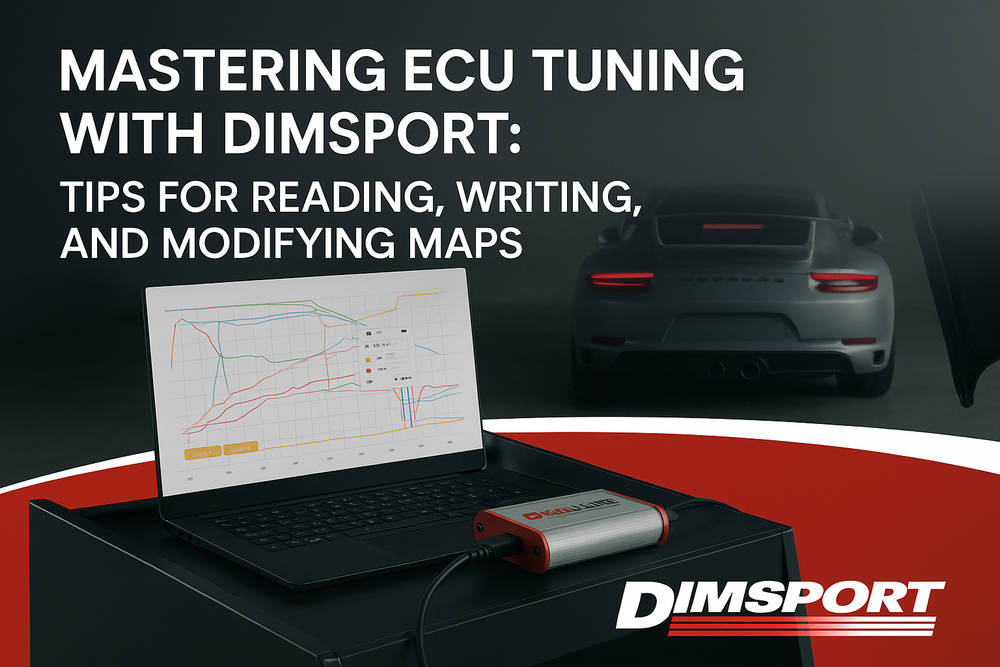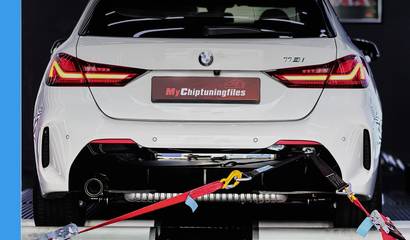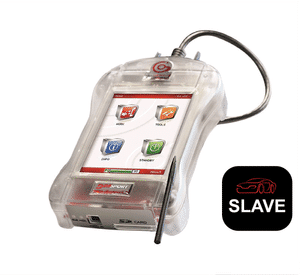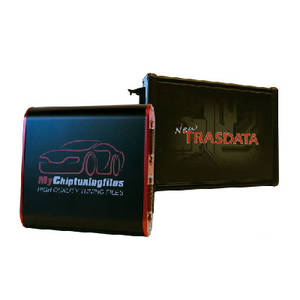Sunday 16 November

If you have been around the tuning world for even a little bit, you have probably heard the name Dimsport thrown around a lot. And for good reason. Dimsport has been one of the go to names when it comes to serious tuning tools. They have been around for a while now and their lineup of tools like New Genius and New Trasdata are absolute workhorses.
But just having the tool does not mean you are going to instantly be some tuning wizard. There is a lot more to mastering ECU tuning than just plugging in and hitting a button. Especially when you are using something as capable and deep as Dimsport hardware and software.
So today we are gonna really dig into it. Real talk. No sugarcoating. If you want to get good at reading ECUs, writing tunes, and modifying maps properly with Dimsport tools, here is everything you gotta know. This is the guide I wish someone handed me years ago when I was starting out.
Grab a coffee. This is gonna be an interesting one.
First Things First: Understanding What Dimsport Actually Offers
Before we get into tips and tricks you need to know what you are working with.
Dimsport mainly offers two big tools for ECU tuning:
- New Genius: This is the tool for OBD reading and writing. You connect to the car through the diagnostic port and do everything without opening the ECU.
- New Trasdata: This is the bench and boot mode tool. If you need to open the ECU or pin onto it directly, this is the tool you are gonna use.
There is also Race EVO which is their tuning software for map editing and file modification.
Some tuners only use one of these. The real pros usually have both so they can handle anything that comes through the door.
Alright cool. Now that we got that out of the way, lets move on.
Also Read: The Ultimate Guide to ECU Programming: Tools, Software, and Services
Step 1: Getting a Solid Read Every Time
The first thing you gotta master is getting a good read from the ECU. If you mess this up nothing else matters.
Here are some big tips to make sure your reads are clean and complete.
Always Always Always Have a Stable Power Supply
This cannot be stressed enough.
When you are reading or writing an ECU, especially over bench or boot mode, you must have a stable battery voltage.
Buy a decent battery stabilizer or at minimum hook up a battery charger. If voltage drops during a read or write you can brick the ECU. And trust me nobody wants to explain that one to a customer.
Target around 13 volts stable throughout the operation. Not 11 volts not 12 volts. Stable at 13.
Check Connection Twice Before Reading
If you are working through OBD make sure the OBD connector is fully plugged in and clean.
If you are doing bench work make absolutely sure your pinout is correct. Do not just eyeball it. Double and triple check the manual and wiring diagram.
A bad connection can give you corrupted reads or incomplete data. Sometimes you will not even know until later when weird stuff starts happening.
Save Two Copies of Every Read
Always save your original read twice in two different folders or drives.
Label them properly. Use customer name and car model and date.
You will thank yourself later when you need to go back and compare files.
Step 2: Understanding What You Are Reading
Once you get the ECU readout you need to understand what you are looking at.
Dimsport tools usually give you:
- Full Read
- Internal EEPROM
- External EEPROM
- Flash Memory
Depending on the ECU and protocol.
Not all of these are always needed for tuning. Usually the flash memory is the main thing for performance tuning.
But knowing what you have is crucial because if you are doing cloning or more advanced repairs you might need the EEPROM too.
Tip: Never just modify stuff blindly. Always know which part of the read you are actually working with.
Step 3: Modifying Maps the Smart Way
Here is where the real art of tuning comes in.
You got your file. You got it open in Race EVO or whatever editor you are using.
Now what
Study Before You Touch
If you are new do not just start dragging numbers up and down.
Spend time understanding what each map does.
- Torque limiters
- Injection timing
- Boost control
- Rail pressure
Changing one thing can throw off five other things. Especially on modern ECUs that are highly torque model based.
Tip: When in doubt, small changes first. Test. Log. Then adjust more if needed.
Use Dimsport Map Packs If Available
Dimsport offers map packs and definitions for many ECUs.
These are life savers.
Instead of hunting for maps manually you get pre labelled maps ready to edit.
Yes they cost extra sometimes. Yes it is worth it.
They save hours of work and reduce mistakes massively.
Always Keep the Original Limits in Mind
When you modify maps it is super tempting to just crank up boost and torque and injection like crazy.
Be careful.
- Turbochargers have limits.
- Fuel systems have limits.
- Clutches have limits.
If you exceed mechanical limits you will break stuff. No magic tune can fix snapped rods or melted pistons.
Respect the hardware.
Also Read: Flex vs. CMD: A Detailed Comparison of Two Powerful Car Tuning Tools
Step 4: Writing the ECU Safely
Writing is where you can make or break the whole job.
Here are the golden rules for writing with Dimsport tools.
Double Check the File
Before writing, always double check the file you are flashing.
Make sure it is for the exact ECU and vehicle you are working on.
Flashing a wrong file can brick the ECU hard. Some mistakes cannot even be recovered easily.
Stable Power Supply Again
Same as reading. You need stable voltage through the whole write process.
No exceptions.
Follow the Software Instructions
Dimsport software is good about walking you through the write steps.
Read every prompt carefully.
Sometimes you need to do ignition cycles. Sometimes you need to leave the ignition off. Sometimes you need to wake up the ECU manually.
Do not rush. Follow exactly.
Wait For Write Complete Message
Do not unplug anything or turn off the ignition until you see the success message.
Even if the progress bar is at 100 percent, wait for the final confirmation.
Trust me.
Step 5: Post Tune Checks
You flashed the car. Great. You are not done yet.
Now you need to check everything carefully.
- Start the car
- Let it idle
- Check for warning lights
- Scan for DTCs
- Check live data (boost pressure, rail pressure, MAF readings)
You want to catch any problems immediately, not after the customer has driven off.
Tip: Always do a quick road test too if possible. Light load then full load if all looks good.
Common Problems and How to Avoid Them
No tuning job ever goes perfectly smooth forever. Here are common issues you will run into and how to handle them.
ECU Lockups After Write
Sometimes after flashing the ECU will not respond right away.
Do not panic.
Give it a few minutes. Cycle ignition. Sometimes they need time to wake up again.
If still no response you may need to bench recover using Trasdata.
Checksum Errors
Dimsport tools usually auto correct checksums.
But if you get a checksum error warning double check your file and make sure the editor you used corrected properly.
Never flash a file with bad checksum unless you know exactly what you are doing.
Weird DTCs After Tune
If you suddenly get new DTCs after tuning, double check your modifications.
Sometimes adjusting torque or airflow maps wrong can trigger unexpected faults.
Always scan codes and fix them properly. Do not just delete codes without understanding why they are there.
Also Read: Stage 1, Stage 2, and Stage 3 Tuning: Which One Is Right for You?
Advanced Tips for Going Pro
Alright if you have made it this far you are serious. Here are some more advanced tips to help you level up even further.
Logging and Data Analysis
Learn how to log important parameters and read the data.
Things like:
- Boost target vs actual
- Injection timing
- Air fuel ratios
- EGTs
Numbers do not lie. Logs show you what the engine is really doing.
Use logs to fine tune your maps, not just guesswork.
Compare Stock and Modified Maps
When you are learning, always compare the original file to your modified file.
See what changed.
This will help you spot mistakes and understand better how each map behaves.
Build a Library of Base Files
Over time you will collect lots of reads from different vehicles.
Organize them.
Build a library of stock files. They are gold for future jobs and repairs.
If a car comes in with a bad tune from another shop you can flash it back to stock easily.
Build a Strong Future: Start a Chiptuning Business with MyChiptuningfiles
Starting a new venture in the automotive world can feel overwhelming, but with the right support, you can succeed with confidence. MyChiptuningfiles makes it easy to start a chiptuning business, even if you’re just getting started.
We provide high-quality ECU tuning files designed by experienced engineers using professional tools like WinOLS. Each file is tested and tailored to boost engine power, torque, and fuel efficiency while maintaining safety and drivability.
You don’t need to be an expert. Simply upload your customer’s original ECU file, and our team handles the tuning. The result is a dependable file you can install with peace of mind. It’s quick, efficient, and designed to fit smoothly into your workflow.
Whether you’re a garage owner expanding your services or an individual looking to build something new, MyChiptuningfiles gives you the technical foundation and support to grow. With fast delivery, responsive service, and years of experience behind every file, we help tuning professionals succeed around the world.
Take the first step toward your business goals. Start a chiptuning business today with MyChiptuningfiles and join a global network of automotive professionals committed to quality and performance.
Final Thoughts: Dimsport is a Powerful Partner
Dimsport did not build toys. They built serious professional tools for people who want to tune right.
If you treat your tools right and respect the process you can do amazing work with Dimsport hardware.
But remember tuning is never just plug and play. It is skill. It is knowledge. It is patience.
Take your time. Study your reads. Understand your writes. Modify carefully. Log everything.
And never stop learning.
Because engines change. ECUs change. And the only way to stay ahead is to keep pushing your own skills.
With Dimsport in your hand and the right mindset in your head there is nothing stopping you.
Go tune something great.
news.related_news
Chiptuning tools
Whether you own a car, truck or tractor: we have the best equipment and software for tuning your petrol and diesel engine. With our chiptuning tools it is possible to easily read out the original engine software of your vehicle and upload it to our website. And then it's up to us to provide you with high-quality and customized chip tuning files. Curious about our range of chiptuning tools? Check it out via the button below!









